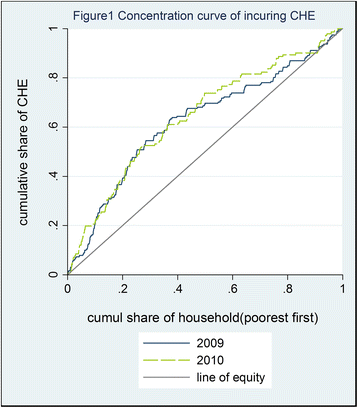Income related inequality and influencing factors: a study for the incidence of catastrophic health expenditure in rural China
- PMID: 28931392
- PMCID: PMC5607576
- DOI: 10.1186/s12889-017-4713-x
Income related inequality and influencing factors: a study for the incidence of catastrophic health expenditure in rural China
Abstract
Background: Catastrophic health expenditure (CHE) puts a heavy disease burden on patients' families, aggravating income-related inequality. In an attempt to reduce the financial risks of rural families incurring CHE, China began the New Rural Cooperative Medical System (NCMS) on a trial basis in 2003 and has raised the reimbursement rates continuously since then. Based on statistical data about rural families in sample area of Jiangsu province, this study measures the incidence of CHE, analyzes socioeconomic inequality related to CHE, and explores the influences of the NCMS on the incidence of CHE.
Methods: Statistical data were acquired from two surveys about rural health care, one conducted in 2009 and one conducted in 2010. In 2009, 1424 rural families were analyzed; in 2010, 1796 rural families were analyzed. An index of CHE is created to enable the evaluation of the associated financial risks. The concentration index and concentration curve are used to measure the income-related inequality involved in CHE. Multiple logistic regression is utilized to explore the factors that influence the incidence of CHE.
Results: The incidence of CHE decreased from 13.62% in 2009 to 7.74% in 2010. The concentration index of CHE was changed from -0.298 (2009) to -0.323 (2010). Compared with rural families in which all members were covered by the NCMS, rural families in which some members were not covered by the NCMS had a lower incidence of CHE: The odds ratio is 0.65 with a 95% confidence interval of 0.43 to 1.00. For rural families in which all members were covered by the NCMS, the increase in reimbursement rates is correlated to the decline in the incidence of CHE if other influencing factors were controlled: The odds ratio is 0.48 with a 95% confidence interval of 0.36 to 0.64.
Conclusions: Between 2009 and 2010, the incidence rate of CHE in the sampled area decreased sharply, CHE was more concentrated among least wealthy and inequality increased during study period. As of 2010, the poorest rural families still had high risk of experiencing CHE. For rural families in which all members are covered by the NCMS, the rise in reimbursement rates reduces the probability of experiencing CHE.
Keywords: Catastrophic health care expenditure; Concentration index; Income related inequality; New Rural Cooperative Medical Scheme,Reimbursement; Out-of-pocket expenditures.
Conflict of interest statement
Authors’ information
Hua You and Hai Gu are co-corresponding authors.
Ethics approval and consent to participate
Ethical approval was obtained from the Medical Faculty Ethics Committee of Nanjing Medical University (file number 316) and written informed consent from every participant was obtained before the investigation.
Consent for publication
Not applicable.
Competing interests
The authors declare that they have no competing interests.
Publisher’s Note
Springer Nature remains neutral with regard to jurisdictional claims in published maps and institutional affiliations.
Similar articles
-
Impact of the New Cooperative Medical Scheme on the trend of catastrophic health expenditure in Chinese rural households: results from nationally representative surveys from 2003 to 2013.BMJ Open. 2018 Feb 8;8(2):e019442. doi: 10.1136/bmjopen-2017-019442. BMJ Open. 2018. PMID: 29439077 Free PMC article.
-
Catastrophic health expenditure in households with chronic disease patients: A pre-post comparison of the New Health Care Reform in Shaanxi Province, China.PLoS One. 2018 Mar 16;13(3):e0194539. doi: 10.1371/journal.pone.0194539. eCollection 2018. PLoS One. 2018. PMID: 29547654 Free PMC article.
-
Does the new cooperative medical scheme reduce inequality in catastrophic health expenditure in rural China?BMC Health Serv Res. 2016 Nov 14;16(1):653. doi: 10.1186/s12913-016-1883-7. BMC Health Serv Res. 2016. PMID: 28052775 Free PMC article.
-
Catastrophic health expenditure, incidence, trend and socioeconomic risk factors in China: A systematic review and meta-analysis.Front Public Health. 2023 Jan 4;10:997694. doi: 10.3389/fpubh.2022.997694. eCollection 2022. Front Public Health. 2023. PMID: 36684860 Free PMC article.
-
A review of the incidence and determinants of catastrophic health expenditure in Nigeria: Implications for universal health coverage.Int J Health Plann Manage. 2019 Oct;34(4):e1387-e1404. doi: 10.1002/hpm.2847. Epub 2019 Jul 16. Int J Health Plann Manage. 2019. PMID: 31311065 Review.
Cited by
-
Explaining Socioeconomic Inequality Differences in Catastrophic Health Expenditure Between Urban and Rural Areas of Iran After Health Transformation Plan Implementation.Clinicoecon Outcomes Res. 2020 Nov 11;12:669-681. doi: 10.2147/CEOR.S261520. eCollection 2020. Clinicoecon Outcomes Res. 2020. PMID: 33204128 Free PMC article.
-
A comparative study of catastrophic health expenditure in Zhejiang and Qinghai province, China.BMC Health Serv Res. 2018 Nov 9;18(1):844. doi: 10.1186/s12913-018-3658-9. BMC Health Serv Res. 2018. PMID: 30413169 Free PMC article.
-
Catastrophic health expenditure of Vietnamese patients with gallstone diseases - a case for health insurance policy revaluation.Clinicoecon Outcomes Res. 2019 Feb 11;11:151-158. doi: 10.2147/CEOR.S191379. eCollection 2019. Clinicoecon Outcomes Res. 2019. PMID: 30804677 Free PMC article.
-
The effect of medical insurance on catastrophic health expenditure: evidence from China.Cost Eff Resour Alloc. 2020 Feb 27;18:10. doi: 10.1186/s12962-020-00206-y. eCollection 2020. Cost Eff Resour Alloc. 2020. PMID: 32127784 Free PMC article.
-
Universal health coverage in the context of population ageing: catastrophic health expenditure and unmet need for healthcare.Health Econ Rev. 2024 Jan 30;14(1):8. doi: 10.1186/s13561-023-00475-2. Health Econ Rev. 2024. PMID: 38289516 Free PMC article.
References
-
- Zhang L, Cheng X, Tolhurst R, Tang S, Liu X. How effectively can the new cooperative medical scheme reduce catastrophic health expenditure for the poor and non-poor in rural China? Tropical Med Int Health. 2010;15(4):468–475. - PubMed
-
- The State Council Leading Group Office of Poverty Alleviation and Development/LGOP: five major reasons for poverty; 2015. Available from URL: http://m.news.cntv.cn/2015/11/21/ARTI1448082051328733.shtml. Accessed 29 July 2017.
-
- World Health Organization . Equity in health and health care: a WHO/SIDA initiative. Geneva: WHO; 1996.
MeSH terms
LinkOut - more resources
Full Text Sources
Other Literature Sources
Medical
Research Materials


